In the year 1911 the United States Army adopted John Browning's .45 caliber semi-automatic pistol as the Model M1911 pistol its standard side arm. It was to serve well in that capacity until 1984, nearly three quarters of a century. Still very popular almost one hundred years later, I wondered what the state of the art in semi-automatic pistols was in or about the year 1911. Was Browning's design ahead of its time, or was it evolutionary?
With this in mind, I went searching for information on pistols that existed in 1911, or in the years immediately preceding or following. A most helpful site was the World of Guns. I have listed below the pistols from that site which were in service in the year 1911 with my opinion of the worth of the pistol. All images used in this post are used with the permission of the copyright owner.
Mauser 1910 Pistol 6.35mm (.25 ACP).
This pistol is one of the more modern looking of this roundup, and unlike many European pistols it uses a box magazine instead of a stripper clip. The caliber, however is too small for defensive uses. It was not unusual at the turn of the 20th century for automatic pistol designs to start with smaller calibers and work up to larger ones. Even John Browning started out with .25 ACP, but European designs finally settled on the 9mm Luger round, while the .45 ACP ruled the U.S. Arms market for the next 50 years.
Roth Steyer Model 1907/M.7 pistol 8mm Roth.
As in America, Europeans introduced many new cartridge designs along with new pistols. This pistol is a striker-fired design that used a stripper clip to load the weapon. European designers seemed to prefer the stripper clip with early designs, but I think they were inferior for defensive use as they are easily damaged and might increase the chances of dirt and debris to foul the action. This pistol bears the distinction of being the first automatic pistol to be adopted by any military service, the Austro-Hungarian cavalry. Note the lanyard ring at the butt of the grip, something shared with the Colt 1911 pistol.
Steyer Hahn M1912 Pistol 9mm X 23 Steyer.
An evolution of the above model, this pistol was also loaded via a stripper clip. This boxy looking pistol is a step along the road to the modern semiautomatic pistol, but consider that the 1911 pistol was adopted the year before, and one can see that this was not an innovative design. Browning designs had been using the slide for over ten years.
FN Browning Model 1910, .32 ACP and .380 ACP
Compare the above pistol to this one: John Browning's Model 1910 pistol from FN Herstal. Introduced two years before the Styer Hahn, this pistol uses a box magazine and is clearly a development of the Browning pistol design philosophy: simple design and multiple safeties: grip safety, magazine disconnect, and thumb safety. Unlike many other pistols in this post, this one was also produced for quite a long time, until around 1983. Millions of these are still in use today.
Webley Scott Model 1910 Pistol (.38 ACP)
I may have never seen an uglier pistol, but it is one with modern mechanisms: box magazine, recoil operated, internal hammer, and, in this one model, a grip safety. Only used in WW I, it was declared obsolete and relegated to civilian and police use.
Frommer M1912 Stop pistol, 7.65x17 Browning / .32 ACP or 9x17 Browning Short / .380 ACP
It may look ugly, but it seems that this pistol was a decent design. Recoil operated, feed with box magazines, this gun was quite reliable and was used until the end of WW II. It did have complicated maintenance procedures, however, and like many European pistols, used an under powered cartridge.
Bergman Bayard Model 1910 pistol, 9mm Largo
This pistol seems to be a throwback, considering that FN had been producing modern Browning designs for ten years by the time, but unlike the Mouser C-96, this pistol uses either box magazines, or stripper clips to recharge the magazine. Only a limited success, it was used only by Denmark. I think all pistols of this basic design must be very unbalanced with the weight of the ammunition forward of the trigger guard.
Mauser C-96 pistol, 7.63x25mm Mauser (.30 Mauser); also 9x19mm Luger/Parabellum and 9x25mm Mauser (rare).
This pistol is included because I was in service in 1911, but it is definitely an obsolete design. The internal magazine was loaded by stripper clips, and the forward position of the magazine must have made this pistol unbalanced. While it was one of the first practical automatic pistols, it was only used by the German Army in WW I when P-08 Luger pistols could not be obtained.
Luger 'Parabellum' 7.65mm Luger/Para, 9x19mm Luger/Para
Here we have the only pistol in the round up that can give the M1911 a run for the money. Chambered in the credible 9mm X 19 Parabellum cartridge, the Luger is a thoroughly modern firearm. Lugers used a locked breech, recoil operated mechanism, and are striker fired and loaded using box magazines. First adopted in 1900, these served at least until the end of WW II. While ergonomic and accurate, they were subject to fouling and expensive to produce.
Campo Giro pistol, 1913
This gun is the predecessor to the Astra Model 400, but it does not save this gun from being one of the ugliest guns of this roundup. Given that it was introduced after the FM Model 1910, the Colt M1911, and the German P-08 Luger, it does seem to be an inferior pistol. While it used a box magazine, it was still a blowback operated pistol, which limits the maximum caliber for which the gun can be chambered. While accurate, it was difficult to disassemble.
Colt 1911, .45 ACP
Saving the best for last, compare this pistol to all other preceding it, and then realize that this pistol was designed in 1906, and that essentially the same pistol is still in use by civilians, police departments, and military organizations (including some U.S. Units), and one can see that this was an outstanding pistol that set the state of the art in the year 1911, as well as setting a standard that few pistols can beat even in the 21st century.
First, let me admit that I am not unbiased. I love this pistol, and I am inclined to think that it is the best close quarters combat pistol ever designed. It is chambered for the hard hitting .45 ACP cartridge, following the American philosophy that bigger holes in a target are better. Why is this pistol still in use today, while most of the others in this article are not? It is because the Colt 1911 combined John Browning's pistol design innovations that he had been developing for the previous ten years in a single pistol that was to prove revolutionary. The important innovations are:
- The slide. John Browning was the first pistol designer to use a slide that completely enclosed the barrel, that contained the cartridge case extractor and recoil spring, and that locked the barrel securely.
- Tilting barrel. John Browning was the first to tilt the breech of the barrel down, in this case using the pivoting link mechanism.
The Colt 1911 pistol was so advanced in it's day that it has defined what a semi-automatic pistol should look like, which is why it still looks modern in the 21st Century.
UPDATE: 3/24/2011
Edited the size of the photographs to more better fit within the text column.
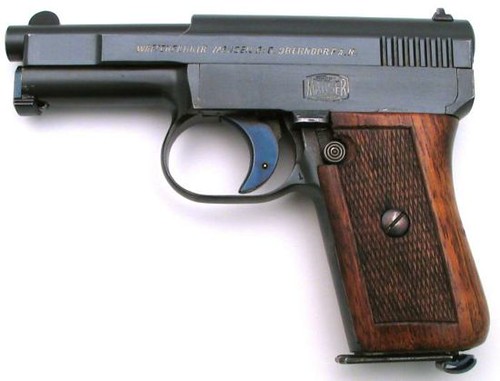
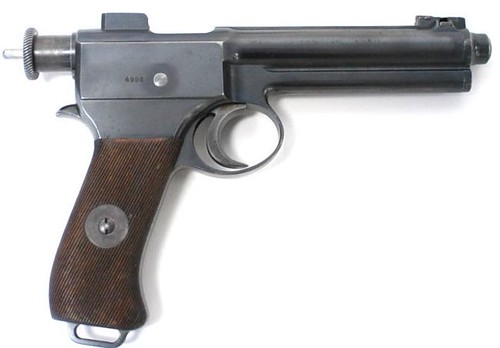
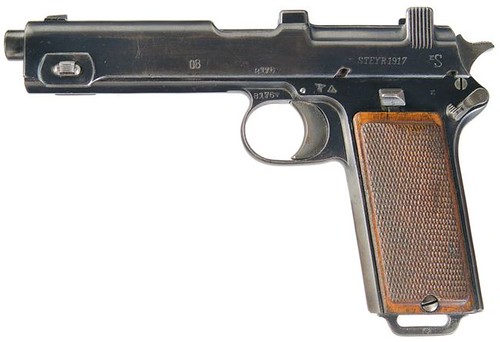
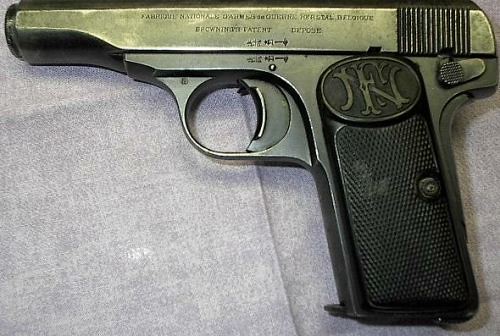
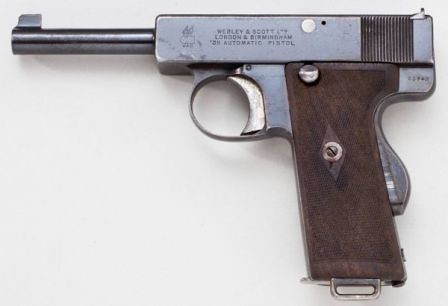
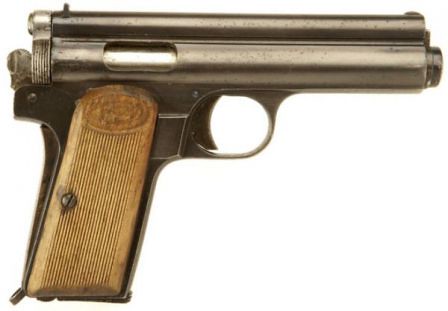
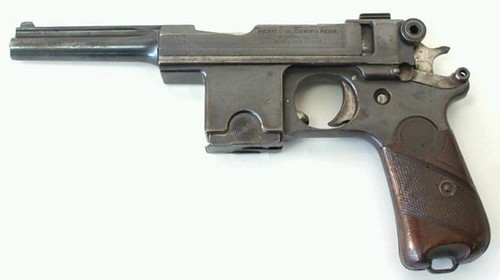
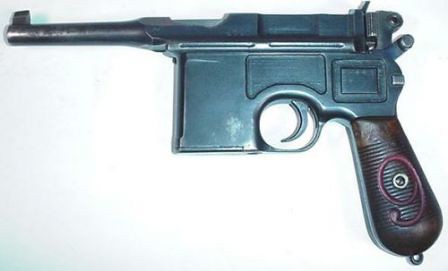
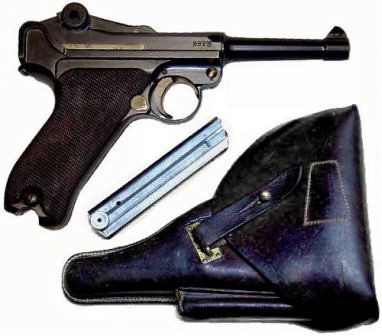
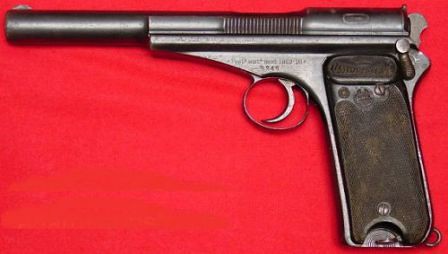
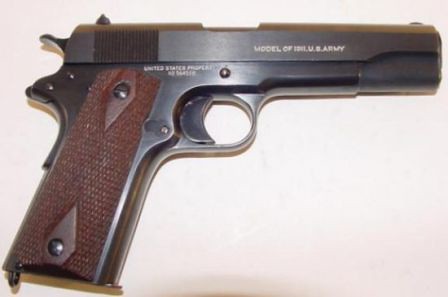
No comments:
Post a Comment